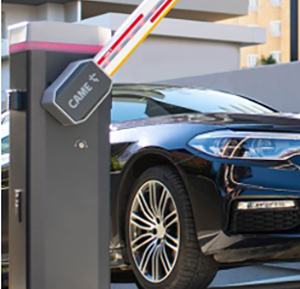Vehicle Exit Sensors
22 January 2024
Drive up to a barrier or automated gate, and it opens for you. How does that work, and what is new?
 What is an exit sensor?
What is an exit sensor?Entrances gates and barriers along with a suitable access control provide secure access to private property. In most cases, any vehicle that approached the automated perimeter will be given free egress. Excluding the need for identification on exit reduces cost and increases traffic flow. The exit sensor can detect a person, or vehicle, and activate the gate or barrier.
Why do we need exit sensors?
So why do we use exit sensors on residential properties, when all automated gates have remote controls? There is the 'wow' factor that impresses guests, like the brass door knobs and gold taps. Where there is an intercom or keypad to let visitors or tradesmen in, a vehicle sensor or an exit button might be used for egress. The longer the driveway, the more sense an exit sensor makes.
It is likely that gates in the UK are the first line of security for the property. Residential automated gates in Europe seldom have exit sensors or an access keypad. Sliding gates are more popular in Europe, where the emphasis is more on security, even for small forecourt parking areas.
Exit sensors in UK are likely to be on larger residential properties where there is an access control alternative to remote controls. One can assume keypad users are occasional trusted visitors or regular tradesmen servicing the property. The exit sensor exists to let out those who entered using the access keypad.
For vehicles only?
Strictly speaking, exit sensors are about the detection of vehicles for the purpose of activating a gate or barrier. But many technologies have varying degrees in the ability to discriminate between a vehicle or any other moving targets. The demand is for vehicle only detection. In residential applications the reason would be to prevent endangerment of children or pets. Commercial car parks may need to confirm that a vehicle is present before a ticket is dispensed.
Induction sensors are still the most common vehicle detector. A coil of cable is buried just below the road surface. The detector module makes the road loop resonate. A vehicle or metal object within their search area changes the resonant frequency beyond a threshold, which activates a relay. Inductive loops can be used for activation or presence. They create their own magnetic field, so are un-affected by out of range interference.
Ground loops are expensive to lay and can be damaged when the road breaks up. Single point ‘miniloops’ are a modern improvement that are less expensive to instal, and robust. As yet, single point inductive sensors are only suitable for activation.
In part 2, we will look at alternative technology and combining technologies
Other Press Releases By This Company
- 19/11/2024 - How physical measures are the heart of rural security
- 15/10/2024 - How sensors in gate motors have made gate automation safer?
- 26/09/2024 - Why you should avoid a wired bus in automation
- 15/08/2024 - Automated pedestrian gates
- 17/07/2024 - How have delivery companies met the demand? by Huw Jones
- 13/06/2024 - Are lifetime warranties a liability or a selling point? by Huw Jones
- 17/05/2024 - Solar powered automation pt1
- 16/04/2024 - Force testing isn’t a breeze
- 15/03/2024 - Brushless motors in automation
- 15/02/2024 - Smart opener raises arms!




